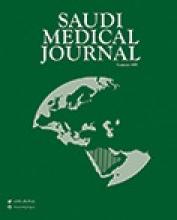Abstract
OBJECTIVE: The objective of the present study was to measure the prevalence of asthma and asthma-related symptoms among male school children in Abha City and to determine some of the possible risk factors influencing its occurrence.
METHODS: A randomly selected sample of 4300 male school children aged 7 to 15 years in Abha were subjected to a previously validated questionnaire for asthma to be completed by parents. Asthma was identified based on the Rush Medical College and International Study of Asthma and Allergies in Children questionnaire. Information of asthma family history, asthma related symptoms, and other atopic conditions, smokers in the family, pets ownership and monthly family income were collected.
RESULTS: The overall prevalence of asthma was 9% (95% Confidence Interval: 7.73%-9.67%). Doctor-diagnosed asthma was reported by 4%, exercise-induced asthma by 4% and wheeze in the past year by 8%. Multiple logistic regression analysis showed that positive family history of atopic condition (Odds Ratio=437.11, P<0.001), pets ownership (Odds Ratio=2.91, p<0.001), and lower monthly family income (Odds Ratio=2.00, P<0.02) were significant factors influencing the development of asthma.
CONCLUSION: In conclusion, the screening methodology adopted in this study could be applied for all children at the beginning of the school year, being simple and non-invasive measure. The prevalence of asthma in school children in Abha is greater than that reported from most developing countries and closer to the rates reported in developed countries. Avoidance of pets ownership at home, improving social class and premarital counselling for atopic persons are all recommended.
- Copyright: © Saudi Medical Journal
This is an open-access article distributed under the terms of the Creative Commons Attribution-Noncommercial-Share Alike 3.0 Unported, which permits unrestricted use, distribution, and reproduction in any medium, provided the original work is properly cited.






